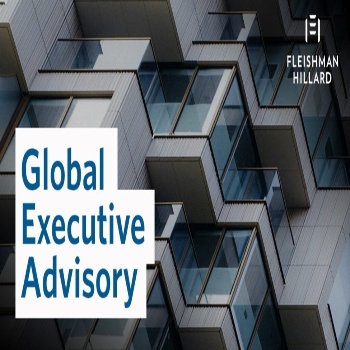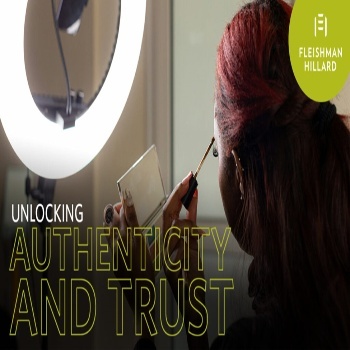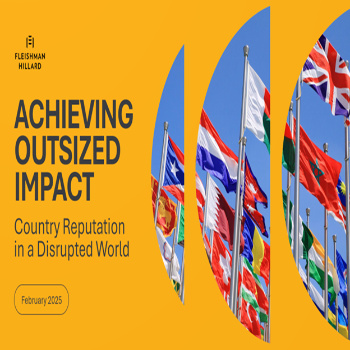Hong Kong Fintech Week 2018 – Day 3 Highlights
Financial Secretary Opens; HKMA on Trade Finance and with 4 CEOs; Digital Banking;
AMTD China Bank Alliance; Revolut, Starling Bank Debate; Insurtech
[October 31, 2018] Day 3 at Hong Kong Fintech Week, organised by Invest Hong Kong (InvestHK) at Hong Kong Exhibition and Convention Centre was buzzed with energy as the three stages hosted speeches and lively panel sessions to full houses, while the numerous fintech company booths attracted delegates amid the hubbub of meetings, photos, interviews and networking.
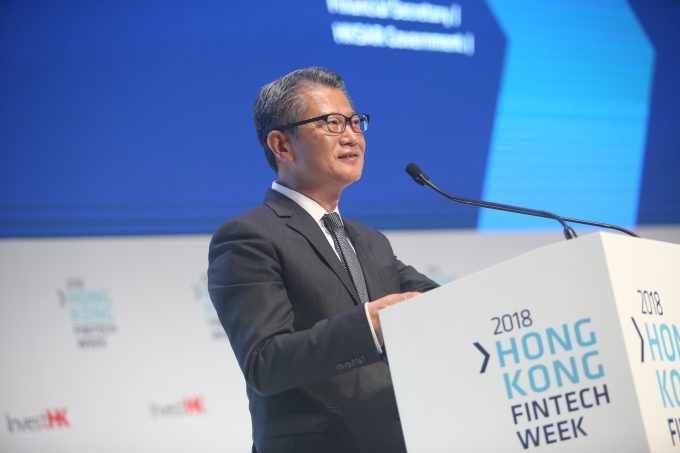
Image credit: Finnovasia
The day opened with a keynote speech given by Paul Chan, Financial Secretary, HKSAR Government, who highlighted Hong Kong’s strengths recent developments in fintech and discussed the city in the context of the Greater Bay Area.
“Some people already call Shenzhen the Silicon Valley of China. Imagine placing Silicon Valley next to New York City?” asked Mr. Chan, referring to Hong Kong neighboring Shenzhen. In this context, he noted the new tagline for InvestHK as capturing the essence of what Hong Kong offers to fintech companies looking for a base in Asia: Launch, Leap, Lead.
It was fintech galore with a focus on regulation for much of the day, thanks to the Hong Kong Monetary Authority (HKMA) shaping part of the programme. A highlight of the morning session was a ceremony to launch eTradeConnect, the HKMA’s blockchain trade finance platform. The ceremony included a symbolic dandelion – the seeds of which blow far and wide, like the seeds of business from the platform – and the 18 corporates involved.
HKMA hosts CEOs for panel discussion
Norman Chan, Chief Executive of the HKMA took the stage after a presentation by Calvin Choi, Chairman of AMTD Group. Norman Chan stressed that “technology and processes are equally important,” and noted the friction between convenience and trust. His comments echoed one of the key themes of the week: the balance between product-centric and customer-centric.

Image credit: Finnovasia
Mr. Chan went on to moderate a keenly awaited CEO panel session involving Eric Jing, CEO of Ant Finance, Jessica Tan, COO and CIO of Ping An Group, Benjamin Hung, Regional CEO of Standard Chartered Bank and Stephen Bird, Global CEO of Citi.
Ms. Tan said the challenge is to get financial services integrated with lifestyle, so that it’s not a chore. She said that for real change, “front-, middle- and back-office change is needed.” To do that, she added, you need to change every process and mindset to get people to work together.
She illustrated capabilities that are transforming insurance. “In China last year, we processed 11 million car accident claims. Of these, 98.7% were paid within a day, 60% were done with self-service, where the users submitted a picture of the incident and got the payment settled automatically.” She added: “It took us three years and 10,000 people working on it to train machines to recognise 25 million different car parts and identify real from fraudulent claims.”
Benjamin Hung of Standard Chartered Bank said the fundamental banking needs of customers have not changed over the years. “It is about how they want to manage, protect and grow their money,” he said. “What has changed is how these needs are being met in face of the changes in technology.”
Banks and fintechs should be complementary, working together to better serve the needs of customers, he said. He emphasised the importance of trust, “where customers deal with their hard-earned life savings.” In this regard, he said the regulators play a very important role.
Eric Jing of Ant Financial talked about addressing the pain points of individuals and SMEs, such as getting financing without collateral and the lack of flexibility in that lending (e.g. fixed term loans).
Mr. Jing referred to Ant Financial’s 3-1-0 approach to loans: three minutes to submit the application, one second to access the credit and send funds, and zero human involvement. With the traditional banks, the experience he had heard was one of “three weeks to do the application, one month to get a response, and zero chance of getting a loan!”
He gave a wealth management example. Previous there was a RMB 10,000 threshold as an entry point to invest with very complicated terms. With technology its possible to reduce that threshold to RMB 10, which is what Yuebao has done and now has more than 300 million people investing in its market money fund.
Commenting on trust, Mr. Jing said that blockchain technology is revolutionary in the way it provides trust. Blockchain shouldn’t be ignored or associated solely with cryptocurrencies, he said.
“We are living through an extinction phase,” said Stephen Bird of Citi. “It’s an epochal shift, more dramatic than electricity or the automobile.” He added that Citi’s 200-year existence demonstrated it has survival and reinvention in its DNA.
AMTD announces China Regional Bank Strategic Alliance
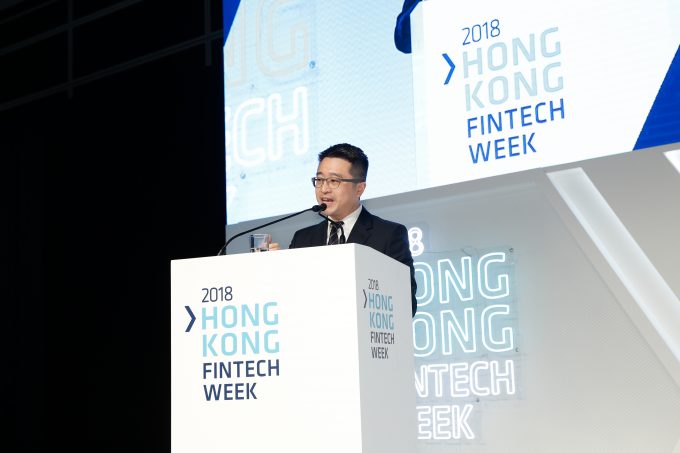
Image credit: Finnovasia
Meanwhile, over on the AMTD stage, Calvin Choi, Chairman and President of AMTD Group, announced the establishment of a Regional Bank “Plus” Strategic Alliance with Zhongyuan Bank, Guangzhou Rural Commercial Bank, Bank of Qingdao and Jiangxi Bank. The Alliance will be headquartered in Hong Kong.
The Alliance is a financial collaboration platform initiated and sponsored by the AMTD Group and the four founding banks mentioned above. The mission of the Alliance is to promote financial innovation, inclusive finance, green finance, and international expansion in compliance with relevant rules, regulations and policies.
Mr. Choi said a growing number of Chinese regional banks are listing in Hong Kong. Against a backdrop of the “Belt and Road” and the “Greater Bay Area” initiatives,s the interconnection between these banks and the Hong Kong capital market ever more important. Offering a more effective platform to connect China’s leading regional banks’ resources with Hong Kong and international markets, the Alliance serves as a super-connector.
Xiaomi on why financial services
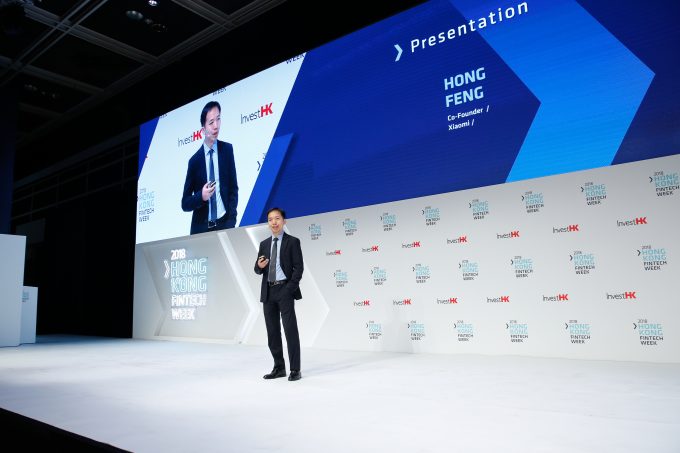
Image credit: Finnovasia
Back on the main stage, Xiaomi Co-Founder Hong Feng reminded the audience how Xiaomi was the fastest company to reach US$10 billion in revenue and the first dual-share listing in Hong Kong. The company is now moving into financial services.
That may seem strange, he said, but Xiaomi has more than 100 other smart devices under its brand. This is thanks to its incubators. He said Xiaomi’s strategy is to take a minority stake in these companies. Their success is testament to the ecosystem Xiaomi has created.
This ecosystem and its deep knowledge of its user-base – in China, it has more than than 300 million mobile users – enables Xiaomi to enter financial services.
“We’re able to leverage hardware with software: mobile to payment card or entry card; wearables to payments and entry for transportation services,” he said, referring to how its products can be applied to financial services, so they understand both sides of the business.
“We see that manufacturers historically struggle to get good financial services, because financial institutions sometimes don’t know what to evaluate,” said Hong Feng. “Xiaomi understands its partners, the manufacturing process, quality control etc. It examines data from end to end, looking at sourcing variables – good tech, good team, activation rates, reputation…”
Banks just look at the balance sheet which is simply the end-result, he said. “Xiaomi looks at the lifestyle which leads to the end balance sheet. We know their quality control, the production rate etc. in real-time… There’s so much data that can be gathered at low cost. It’s the source variables that determine likely success for a company.”
Tencent sees huge growth potential in Greater Bay Area
Jim Lai, Vice President at Tencent, said there’s a lot of room for growth with the Greater Bay Area initiative. “With the right approach, and enough support from regulators from both sides, I believe we can bring 10 times’ growth for a lot of the financial institutions including banks, insurance companies, and wealth managers in the next five years,” he said.
Fintech applications will speed up and widen the penetration of business, he said, pointing to remote account opening via facial recognition technology as examples. Apart from payment solutions, Mr Lai also saw wealth management products, securities trading tools as areas of great opportunities for fintech innovation.
Making money in Russia
Moscow-based Tinkoff Bank is the biggest digital bank in the world and it’s very profitable, said its founder Oleg Tinkov. He said it has 7 million customers, employs 12,000 people with 70% of them in IT. He added that the average age of his staff is 24-years-old.
“If you want to make money, you have to go to Russia,” said Tinkov, adding that Moscow is the best place for digital talent after Silicon Valley. He said the bank does retail and SME business, and is moving into lifestyle banking, adding 500,000 new accounts a month. “We are successful because we are focused on Russia,” he said. “We know our customers, we know what they want. We focus on them.”
Hong Kong the place to tap Greater Bay Area and Belt and Road
Over on the Hong Kong stage, the audience listened as Charles D’Haussy, Head of Fintech at InvestHK, talked about the opportunities presented by the Greater Bay Area and Belt and Road Initiatives.
“It is going to be the biggest deployment of financial technology in human history,” he said, referring to the “Belt and Road Initiative” which covers 62% of the world’s population. “The populations in the Belt and Road are mostly served with primary infrastructure in financial services. We are talking about business opportunities for the next 25 years.”
The B2B fintech offerings in Hong Kong will complement the fintech scene in the Mainland which focuses on B2C, he said. As of now, there are 550 fintech companies in Hong Kong with a good mixture of B2B fintech offerings, with blockchain and cryptocurrencies, payments and remittances, and wealthtech being the top three areas of focus.
Starling Bank and Revolut
Megan Caywood, Co-founder and Chief Platform Officer of Starling Bank, a tech start-up with a banking license in the UK, talked about how open API platforms create a new type of marketplace for both banks and other types of companies to offer banking as a service.
Starling Bank, for example, had created a marketplace for customers to choose from a variety of services and products offered by partnering banks, financial institutions and fintech companies. With the authorization of their customers, data will be shared with the partnering banks and financial service providers to speed up the cycle of innovation in products and services, and matching customer needs with the right offerings.
She also pointed out the advantage of gaining a full banking license for fintech companies is that they will be in a stronger position to compete with traditional banks as the general public still have the habit to retain a banking account even as they utilise payment technology and other fintech applications. At the same time, digital only banks enjoy a much lower overhead cost but have a much nimbler business model.
Chad West, CMO of UK-based Revolut, explained how Revolut took a different approach to Starling Bank by opting to focus on growing its customer base. He said that Revolut aims to get a banking license shortly, and that it would be expanding into Asia and Australasia in coming months.
Mr. West said Revolut has achieved 3 million retail customers with “zero advertising.” He laid out the Revolut’s priorities: giving customers control over their money, so they know when and how it’s being spent with budgeting options in multiple currencies; offering value, such as interbank exchange rates, real-time transactions, while noting that “banks have stung consumers on fees for years.”
He highlighted other features offered by Revolut, such as on security, anti-fraud processes built around tracking behavioral patterns and transaction monitoring, along with full customer engagement, including letting them crowdfund and therefore have a stake in the company.
The panel session that followed, moderated by James Lloyd, APAC FinTech Leader at Ernst & Young, saw Ms. Caywood and Mr. West politely disagree on which route to take up the mountain: bank license first, with the constraints and benefits that go with it; or acquire customers first to get critical mass before applying for a license. The audience was entertained.
From bricks and mortar to virtual
After Starling Bank and Revolut, came Henry Ma, CIO of WeBank, and Michael Gorriz, Group CIO of Standard Chartered Bank.
Mr. Gorriz explained how Standard Chartered Bank, a traditional bricks and mortar bank, moved into virtual banking to reach customers in emerging economies, where the growth in customer numbers couldn’t be matched by a growth in physical presence. “This,” he said, “is the first segment of customers.” The second segment of customer are the millennials who want the services without the waiting, queuing and hassle of traditional banking.
He said Standard Chartered has a sizeable market share in Hong Kong, but it realised there’s a need for virtual banking here. to do it here. They studied the environment closely and crafted the bank from outside-in for the segment being targeted. For the architecture, he emphasised the need to start from a full fresh base. “Don’t put legacy systems behind it,” he said. “New architecture can be linked to old through restful APIs.”
Mr. Gorriz said Standard Chartered tapped internal expertise and then hired from outside. The team has full autonomy, but can get help as needed. “Teams must be incentivised with the same KPIs so they can see the success of their work,” he said. “Hopefully the HKMA will grant a license.”
WeBank’s Henry Ma described how it can of offer services anytime anywhere in China, making it very different from the traditional incumbents. He said how market fundamentals and timing were important when WeBank launched. “China is hugely populated, with a fast-growing middle class, very connected with more than half the country using smartphone; and with an economy that’s more than 50% service focused.”
Mr. Ma explained how only 9% of people in China can go to financial institutions to get loans. Far more go to family or friends. WeBank banks it much easier with much lower entry points (RMB 500) for loans and for much more flexible periods. It now has 80 million customers.
Before the year-end, the HKMA is set to announce the first of the virtual banking licenses to be granted. As of the end of August, 29 banks and other companies had submitted applications to the HKMA. These include Standard Chartered Bank, Airwallex and WeLab. Executives from each of them described their strategies and objectives, along with how they have gone about developing their infrastructure.
Insurtech hotting up
Speaking on the AMTD stage, Scott Walchek, Founder, CEO and Chairman of Trov, said insurtech made it possible for people to insure anything, anytime from anywhere. Trov offers on-demand insurtech for single items. He said insurtech enables “event-triggered ephemeral coverage” where further stratification of insurance coverage, including which object to insure and when, could be further stratified.
Insurers, on the other hand, will also be able to individualise premium payments based on data, such as that of car insurance coverage based on mobility data collected from intelligent cars or other location tracking devices.
Alan Lau, Chairman and CEO of WeSure, said: “Insurance is one of the most complicated financial products. Insurtech is offering new ways to reach users and give the market a new set of capabilities to design products, especially when the users of insurtech are mostly young working adults who have never used insurance products before.”
Wayne Xu, President of ZhongAn International, highlighted that generation, processing and protection of data as a key issue for insurtech. “Insurers need to understand the source of data in terms of how it is generated before they can proceed to process the data from a user’s perspective, instead of a product-centric manner,” he said. “They will also have to make sure they have the trust of their customers, so that they will consent to providing access to their data to help insurers underwrite their policies.”
Raymond Tam, Executive Director, Insurance Authority, said: “Among the different strands of fintech, the biggest change will be AI, because it AI not only changes the onboarding process and the financial needs analysis, but also changes the pricing, underwriting, and the back offer processing. AI is going to make a tremendous impact on a 300 years old industry.”
